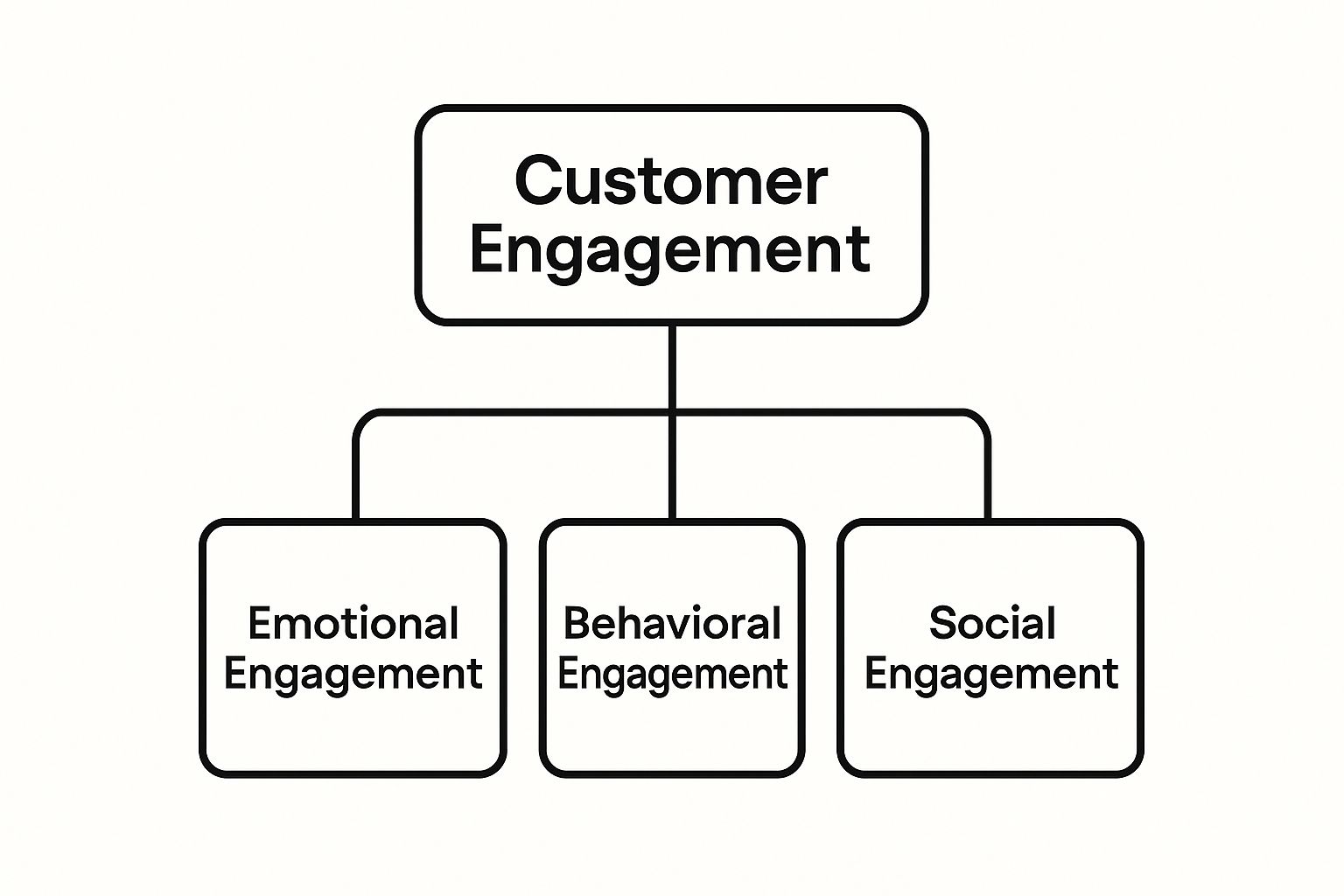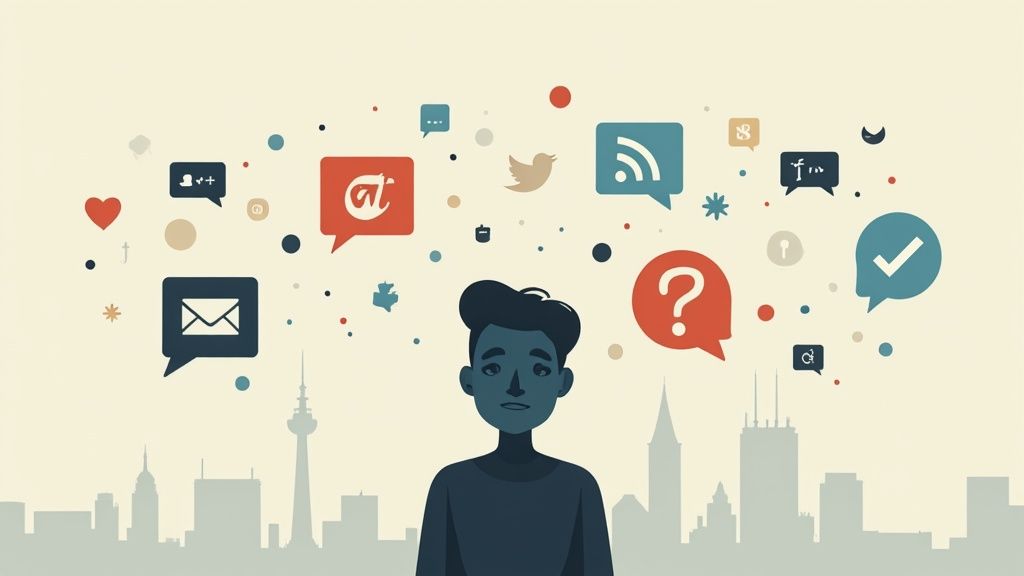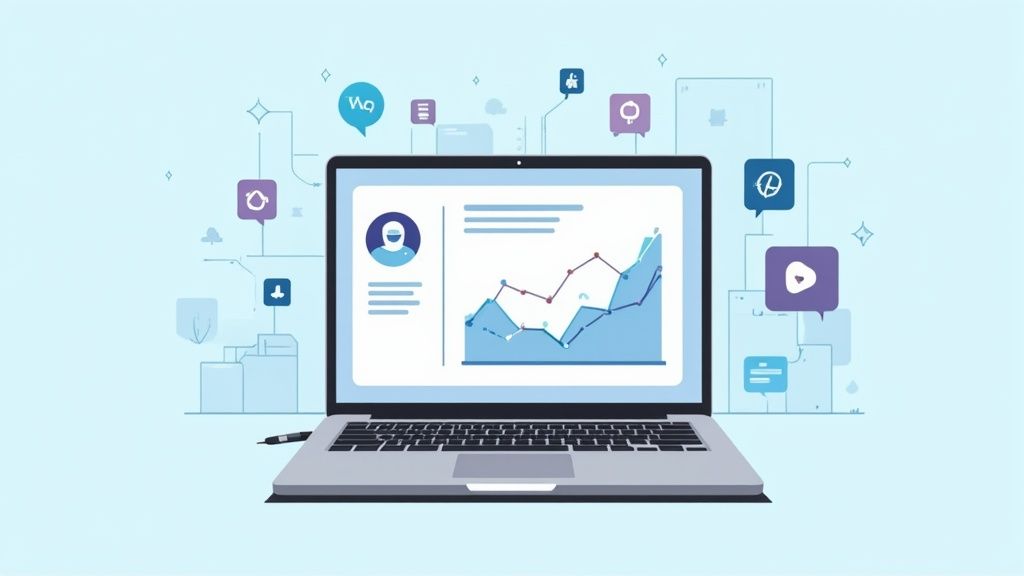So, what do we actually mean when we talk about customer engagement?
It’s more than just a buzzword. At its heart, customer engagement is the ongoing, two-way relationship a customer builds with your brand. Think of it less like a single transaction and more like a genuine friendship—it’s built on a foundation of repeated, meaningful interactions that create a strong emotional connection over time.
It's the difference between someone who just buys your coffee and someone who considers your coffee shop their spot. That feeling doesn't happen by accident.
This connection isn't a one-way street where you just blast out marketing messages and hope for the best. Real engagement is a dynamic exchange where you listen just as much as you talk. Every single touchpoint—from a thoughtful reply to a social media comment to a genuinely helpful support email—is a brick in the foundation of that relationship.
Understanding the Components of Engagement
To really get it, you have to see that customer engagement isn't just one thing. It's a mix of how customers think, act, and communicate when it comes to your brand. Each piece plays a critical role in turning a one-time buyer into a loyal fan.
This infographic does a great job of breaking down the core pillars.

As you can see, engagement branches out into emotional, behavioral, and social dimensions. Looking at it this way helps you figure out where your customer relationships are rock-solid and where you might have some room to grow.
The Four Pillars of Customer Engagement
To take this a step further, we can break down a strong engagement strategy into four distinct pillars. This table shows how a customer moves from simply being aware of your brand to actively championing it.
| Pillar of Engagement | Description | Example |
|---|---|---|
| Cognitive | This is the "thinking" part. It’s about how much mental energy a customer dedicates to your brand. Are you top-of-mind? | A customer actively looks for your new product releases instead of stumbling upon them. |
| Emotional | This pillar is all about feelings. It’s the positive emotional connection a customer has with your brand, like trust, pride, or happiness. | A customer feels a sense of belonging when they see your logo or interact with your community. |
| Behavioral | This is the "doing" part. It covers all the actions a customer takes, from making repeat purchases to using a loyalty program. | A user logs into your app daily, not just to make a purchase, but to browse and interact. |
| Social | This is where customers become advocates. They share their positive experiences, leave reviews, and recommend you to their friends and family. | A happy customer posts an unboxing video of your product on their Instagram story. |
Each pillar builds on the last, creating a powerful cycle that strengthens the customer-brand relationship at every stage.
Key Takeaway: Customer engagement isn't a single event. It's the sum of all the little interactions that make a customer feel seen, heard, and valued. It’s what transforms them from a passive buyer into a true advocate for your brand.
Ultimately, a killer engagement strategy is what turns fleeting transactions into lasting relationships. It’s about building a brand that people don’t just buy from, but one they truly believe in and want to be a part of. That foundation of trust and connection is what really sets the best businesses apart.
Why Engagement Is Your Business Survival Tool
In a market flooded with options, just having a great product isn't the winning ticket it used to be. Customer engagement has evolved from a fluffy marketing term into a core survival strategy. It’s the secret sauce that turns a one-time sale into a long-term, loyal relationship, building a brand that doesn't just survive—it thrives.

Think of your engaged customers as your most valuable players. They aren't just entries in a spreadsheet; they're the lifeblood of your business. These are the people who buy more, stick with you longer, and rave about you to their friends, directly pumping up your customer lifetime value (CLV).
On top of that, forging a genuine emotional bond makes your business far more resilient. When you build real relationships, customers are much more likely to forgive an occasional hiccup—a shipping delay, a minor product bug. They see the people behind the brand and are willing to give you the benefit of the doubt.
The Financial Impact of a Genuine Connection
This isn't just about creating warm, fuzzy feelings. Strong customer engagement hits your bottom line, hard. The data is clear: companies that nail customer engagement consistently leave their competitors in the dust when it comes to profitability.
Here’s how that connection turns into real dollars and cents:
- It Slashes Churn: When customers feel seen and valued, they have little reason to jump ship to a competitor, even for a better price. They're invested.
- It Boosts Revenue: It's simple—highly engaged customers spend more. We're talking about a significant increase in annual revenue compared to their less-engaged peers.
- It Creates Brand Advocates: These customers become your most powerful marketing channel. An authentic recommendation from a friend is infinitely more credible than any ad you could ever run.
We're seeing a fundamental shift in what people value. The overall experience a customer has with your brand now often matters more than the price tag.
Research drives this point home: 88% of customer experience pros say quality is the top driver of loyalty, beating out price, which only 70% cited. And with over 50% of customers ready to walk away after just one bad interaction, the stakes couldn't be higher. You can dig into more of these insights about the importance of customer experience on Zendesk.
The message is loud and clear: if you aren't actively engaging your customers, you can bet your competitors will be.
Engagement as Your Innovation Engine
Beyond just keeping customers and making more money, your engaged audience is a goldmine of honest, unfiltered feedback. Because they're invested in your success, they’re often the first to tell you what’s working, what’s not, and what they wish you’d build next.
This creates an incredibly powerful feedback loop that fuels constant innovation. By truly listening to your biggest fans, you get a direct line into what the market actually wants, allowing you to develop new products and tweak your services with confidence.
So, what is customer engagement? It’s a proactive strategy for building a future-proof brand that doesn't just hang on but leads the pack.
It's easy to get 'customer engagement' and 'customer experience' (CX) mixed up. People often use them interchangeably, but they’re two sides of the same coin, and understanding how they fit together is the secret to building a brand people genuinely connect with.
Think of customer experience as the entire journey someone has with your brand. It’s the sum of every single touchpoint, from the moment they first see your ad to the day they unbox your product and every support email they send. It’s the feeling they walk away with after all those interactions.

Customer engagement, on the other hand, is what happens because of that experience. It’s the active, emotional reaction that a great CX sparks.
Experience Is the Foundation, Engagement Is the Outcome
A perfect way to see the difference is to think about a concert.
- The Experience (CX): This is everything that makes the show happen smoothly. How easy was it to buy tickets? Was the sound quality great? Were the seats comfortable? That’s the entire operational side of things.
- The Engagement: This is the crowd singing along to every word. It’s the thunderous applause after a song and the massive line for merchandise on the way out.
One directly fuels the other. A fantastic experience sets the stage for engagement, but it doesn't guarantee it. True engagement is what turns a passive concert-goer into a die-hard fan who buys tickets for the next tour.
Customer engagement is a direct reflection of the quality of the overall customer experience. But here's the catch: many brands are fumbling the ball. Recent data reveals a troubling trend, with 25% of North American brands seeing their CX scores drop for two years straight. You can dig into the numbers in Forrester’s Global Customer Experience Index.
This slide shows that just having a functional experience isn't cutting it anymore. Customers crave a reason to connect on a deeper level.
Take an e-commerce store, for example. The experience is how easily a customer can navigate your site and find what they need. The engagement is when they’re so impressed by the whole process that they leave a five-star review. This is where things like top-notch visuals come into play. For anyone on Shopify, using professional Shopify product photography can radically improve that initial experience, which in turn builds the trust needed for real engagement.
Ultimately, you can't get that deep, loyal engagement without first delivering a consistently positive experience.
How to Measure What Truly Matters
If you can't measure customer engagement, you can't improve it. It’s that simple. Relying on a vague feeling that your customers are happy just won't cut it. You need hard data to see what’s actually working and what needs a little love.
This means looking beyond surface-level numbers like page views and digging into the signals that point to a genuinely healthy customer relationship.
Think of it like a doctor checking a patient's vital signs. A single number, like temperature, doesn’t tell the whole story. But when you combine it with blood pressure, heart rate, and other indicators, you get a clear picture of overall health. The same goes for customer engagement—you need to look at what customers do, how they feel, and how they share their experiences.
Behavioral Engagement Metrics
Let's start with the most direct feedback: customer actions. Behavioral metrics track what people are actually doing, giving you a clear, quantifiable look at their habits and loyalty.
- Purchase Frequency: Are customers coming back for more? A high purchase frequency is a gold-star indicator of a loyal, lasting relationship.
- Time on Site / Session Duration: Do people stick around, or do they bounce immediately? Longer sessions usually mean they're genuinely interested in what you have to offer.
- User Activity Rate: This is all about tracking key actions. How many of your active users are logging in, using a core feature, or completing a specific task within a certain timeframe?
These actions tell a story about how integrated your brand has become in your customers' lives. For a deeper look at tracking these actions, the ProdShot dashboard offers tools to help you visualize user interactions and pinpoint where conversions happen.
Emotional and Attitudinal Metrics
While behavior shows what customers do, emotional metrics reveal how they feel. This is where you measure the actual strength of the connection you’ve built with them. It’s one thing for someone to buy from you; it’s another for them to love doing it.
Key Insight: Understanding customer feelings is just as important as tracking their actions. Positive sentiment is a leading indicator of repeat business and brand advocacy.
So, how do you capture these feelings? Here are a few tried-and-true methods:
- Net Promoter Score (NPS): The classic "How likely are you to recommend us?" question. It neatly segments customers into Promoters, Passives, and Detractors, giving you a straightforward score of brand loyalty.
- Customer Satisfaction Score (CSAT): This is usually a quick rating after a specific interaction, like a support chat or a purchase. It’s perfect for pinpointing bright spots and pain points along the customer journey.
- Customer Effort Score (CES): This metric asks a simple but powerful question: "How easy was it to get what you needed?" Making things easy is a huge driver of loyalty—a whopping 94% of customers who have a low-effort experience will buy from that same company again.
Proven Strategies to Deepen Customer Connections
Alright, so you know what customer engagement is and you're tracking the right numbers. That's a great start. But the real question is, how do you actually do it?
The best brands don’t just cross their fingers and hope for engagement. They build systems, frameworks, and a company culture designed to create it. It's time to move from theory to action with a playbook of proven strategies that build genuine, lasting connections.

These strategies go way beyond simple transactions. They're about creating shared value and a sense of belonging that turns passive buyers into passionate advocates for your brand. Let's dig in.
Build a Thriving Brand Community
One of the most powerful things you can do is give your customers a place to connect with each other. A brand community isn't just a fan club; it’s a space where you transform a scattered customer base into a unified group centered around a shared interest: your brand.
Look at what Lego did with its "Lego Ideas" platform. They didn't just sell plastic bricks. They built a hub where fans could submit their own designs, vote on others, and maybe even see their creation become an official Lego set. It's a brilliant move that turns customers into co-creators, giving them a real sense of ownership and investment in the brand's future.
Deliver Hyper-Personalized Experiences
Let's be honest, today's customers expect you to know them. Generic, one-size-fits-all messages are a one-way ticket to the spam folder. Hyper-personalization is about using customer data to create experiences that feel like they were crafted just for one person. It shows you're actually paying attention.
Netflix is the undisputed champion here. Its recommendation engine is more than just a list of movies. It analyzes everything—your viewing habits, what you rate, even the time of day you watch—to build a homepage that feels completely bespoke. That level of personalization makes you feel understood, which is why people spend hours scrolling and watching.
Key Takeaway: Personalization isn't just sticking
{{first_name}}in an email subject line. It’s about delivering the right thing, at the right time, on the right channel. It's about making every single interaction feel relevant and valuable.
To really nail this, it helps to follow established best practices for consumer engagement that provide a solid framework for your efforts.
Create Loyalty Programs That Offer Real Value
A great loyalty program is about so much more than discounts. It's about making your best customers feel special and genuinely rewarded for sticking with you. The goal is to offer exclusive benefits that make them feel like true insiders.
Effective loyalty programs often have a few key ingredients:
- Tiered Rewards: Offer better and better perks as customers spend more. It gives them something to strive for and deepens their relationship with your brand.
- Experiential Benefits: Give them something money can't buy, like access to exclusive events, early product drops, or unique content.
- Community Recognition: Sometimes, a simple shout-out or a "member of the month" feature is all it takes to create a powerful sense of belonging.
When you put these strategies into play, you kickstart a powerful, self-reinforcing cycle. You provide value, your customers engage more deeply, and that engagement fuels your company's growth. It’s proof that investing in relationships isn't just a nice idea—it's the smartest strategy of all.
The Future of Engagement with AI and Tech
Emerging tech, particularly artificial intelligence, isn't just giving us a new set of tools—it's completely rewriting the rules of customer engagement. We're moving away from simply reacting to customer needs and toward proactively predicting them. This shift is allowing brands to build more meaningful, seamless experiences on a scale we've never seen before.
At the heart of this change is AI-powered personalization. Forget about one-size-fits-all marketing campaigns. AI can now sift through individual customer data to deliver the perfect message at the precise moment it will land best. This creates a powerful feeling of being seen and understood, which is the bedrock of any strong customer connection.
Augmenting Human Connection with AI
The goal here isn't to replace the human element but to supercharge it. Think of it this way: intelligent chatbots and AI assistants can handle all the routine questions instantly, 24/7. This frees up your human support agents to focus their energy and empathy on the more complex, high-stakes issues where a real conversation makes all the difference.
This one-two punch creates a more efficient and satisfying experience for everyone. In fact, current forecasts predict that AI will power a staggering 95% of all customer interactions in the near future. And with 58% of customers saying tech like chatbots has changed their expectations, getting on board is no longer optional.
The real magic is using technology to understand customer needs on a massive scale, then using those insights to make every single interaction feel personal and effortless.
To really get a handle on how this technology is shaping future interactions, exploring the full potential of AI for customer engagement is a great next step.
This evolution is even changing the visual side of things. An AI product photo generator, for instance, can create stunning, on-brand images that grab a potential customer's attention from the very first glance—which is always the first step toward lasting engagement.
Of course. Here is the rewritten section, crafted to sound completely human-written and match the provided style guide.
Common Questions About Customer Engagement
As you start to really dig into customer engagement, a few questions always seem to surface. Getting your head around these is the key to building a strategy that actually works. Let's clear up some of the most common ones.
Satisfaction vs. Engagement: What Is the Real Difference?
It’s easy to mix these two up, but they’re worlds apart. Think of it this way: customer satisfaction is a fleeting feeling. It’s that happy sigh after a great meal at a new restaurant. It’s temporary and tied to a single moment.
Customer engagement, on the other hand, is the long game. It's what makes you a regular at that same restaurant. It's the sum of all the good meals, the friendly staff who know your name, and the feeling that you belong there. Satisfaction is a reaction; engagement is a relationship.
Boosting Engagement on a Tight Budget
You don't need a huge marketing fund to make people feel connected to your brand. For small businesses, it’s often the small, thoughtful actions that pack the biggest punch. It’s about being genuine, not spending a fortune.
Here are a few ideas that cost more in effort than in cash:
- Listen actively on social media. Don't just post—respond to comments and questions like a real person.
- Send personalized thank-you emails. A quick note that mentions the specific product they bought shows you’re paying attention.
- Start a simple rewards program. Even a small, exclusive perk for repeat customers makes them feel valued.
Authenticity costs nothing. A real, human-centered approach will almost always beat a slick, expensive campaign because it builds trust. It shows your customers they’re more than just a number on a sales report.
Can Engagement Be Negative?
Oh, absolutely. Engagement isn’t always sunshine and five-star reviews. A wave of public complaints, bad reviews, or angry comments on social media is a very real—and very loud—form of negative customer engagement.
But here's the secret: don't view it as an attack. See it as free, unfiltered feedback. When you step up and handle criticism with honesty and a genuine desire to fix the problem, you can turn your harshest critics into your biggest fans. Proving you can make things right often builds more loyalty than a perfect record ever could.
Ready to create stunning product visuals that capture attention and drive engagement? With ProdShot, you can turn simple photos into professional, studio-quality images in seconds. Start your free trial today and see the difference.

